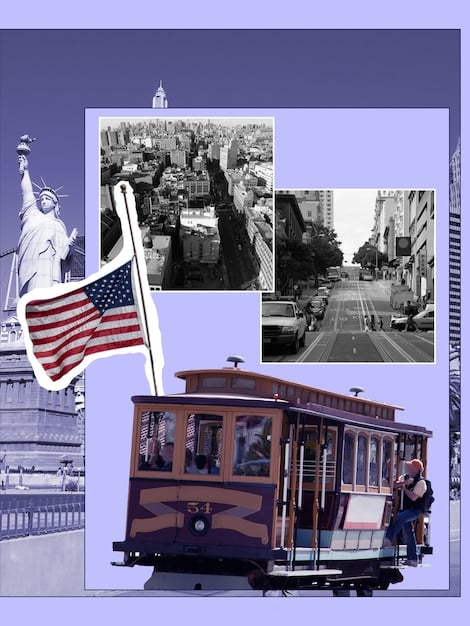US Immigration Policy: A Historical Perspective to 2025

A Historical Perspective on the Evolution of US Immigration Policy Leading to 2025 reveals a complex interplay of economic needs, social anxieties, and political ideologies shaping entry laws and border controls to project future trends.
The United States’ immigration policy has undergone significant transformations throughout its history. Understanding a historical perspective on the evolution of US immigration policy leading to 2025 requires examining key legislative milestones, shifts in public opinion, and the ever-changing global landscape that influences these policies.
Early Immigration Policies in the US
Early immigration policies in the United States were largely shaped by the need for labor and the desire to populate the country. These policies were generally open, with few restrictions, encouraging immigration from various parts of the world.
The Naturalization Act of 1790
The Naturalization Act of 1790 was one of the first laws defining who could become a US citizen. It limited naturalization to free white persons, reflecting the racial biases of the time.
The Alien and Sedition Acts of 1798
The Alien and Sedition Acts of 1798, passed during a period of tension with France, increased the residency requirement for citizenship and allowed the president to deport aliens deemed dangerous.
- These early policies set the stage for future debates on immigration.
- The Naturalization Act highlights early racial biases in immigration laws.
- The Alien and Sedition Acts demonstrated the government’s power to restrict immigration during times of perceived crisis.
In summary, early immigration policies in the US were influenced by factors such as labor needs, racial biases, and political tensions, laying the groundwork for future immigration legislation.

The Era of Mass Immigration (1880-1920)
The late 19th and early 20th centuries saw a surge in immigration to the US, primarily from Europe. This period of mass immigration brought significant economic growth but also led to nativist sentiments and calls for stricter immigration controls.
The Chinese Exclusion Act of 1882
The Chinese Exclusion Act of 1882 marked a significant turning point in US immigration policy. It prohibited the immigration of Chinese laborers, reflecting growing anti-Chinese sentiment on the West Coast.
Immigration Act of 1917 and National Origins Quota Act of 1924
The Immigration Act of 1917 and the National Origins Quota Act of 1924 further restricted immigration by imposing literacy tests and establishing quotas based on national origin. These laws favored immigrants from Northern and Western Europe.
- The Chinese Exclusion Act was the first major law restricting immigration based on ethnicity.
- The 1917 and 1924 acts solidified discriminatory immigration policies.
- These laws reflected nativist sentiments and a desire to preserve the existing racial and ethnic makeup of the country.
In conclusion, the era of mass immigration was characterized by both significant economic growth and increasing restrictions on immigration, driven by nativist sentiments and discriminatory ideologies.
The Impact of the Great Depression and World War II
The Great Depression and World War II significantly impacted US immigration policy. The economic hardship of the Depression led to decreased immigration, while the war brought about new policies related to refugees and wartime labor.
Decreased Immigration During the Great Depression
During the Great Depression, immigration to the US decreased significantly due to economic hardship and high unemployment rates. Many immigrants even returned to their home countries.
The Bracero Program
The Bracero Program, established during World War II, allowed Mexican laborers to work temporarily in the US agricultural sector to address labor shortages caused by the war.
- The Great Depression led to a sharp decline in immigration to the US.
- The Bracero Program provided a temporary labor force during World War II.
- These events highlighted the impact of economic and geopolitical factors on immigration policy.
In summary, the Great Depression and World War II brought about significant changes in US immigration policy, reflecting the impact of economic hardship and wartime labor needs.
The Immigration and Nationality Act of 1965
The Immigration and Nationality Act of 1965, also known as the Hart-Celler Act, was a landmark piece of legislation that significantly altered US immigration policy. It abolished the national origins quota system and prioritized family reunification and skilled workers.
Abolition of National Origins Quota System
The 1965 Act abolished the discriminatory national origins quota system, which had favored immigrants from Northern and Western Europe.
Preference System for Family Reunification and Skilled Workers
The Act established a preference system that prioritized family reunification and skilled workers, leading to a shift in the demographic composition of immigrants to the US.
- The 1965 Act marked a significant shift towards a more equitable immigration system.
- It led to increased immigration from Asia, Latin America, and Africa.
- The Act’s emphasis on family reunification has had lasting social and demographic impacts.
In conclusion, the Immigration and Nationality Act of 1965 transformed US immigration policy by abolishing the national origins quota system and prioritizing family reunification and skilled workers, leading to a more diverse immigrant population.

Contemporary Immigration Debates and Policy Changes
Contemporary immigration debates in the US revolve around issues such as border security, undocumented immigration, and the economic impact of immigration. These debates have led to various policy changes and proposals.
Increased Border Security Measures
In recent decades, there has been a significant increase in border security measures, including the construction of fences and increased surveillance technology, particularly along the US-Mexico border.
Deferred Action for Childhood Arrivals (DACA)
The Deferred Action for Childhood Arrivals (DACA) program, established in 2012, provides temporary protection from deportation and work permits to undocumented immigrants who came to the US as children.
- Contemporary debates highlight the tension between border security and humanitarian concerns.
- DACA has provided relief for many undocumented immigrants who grew up in the US.
- These policies reflect ongoing debates about the role of immigration in American society.
In summary, contemporary immigration debates and policy changes in the US reflect ongoing tensions between border security, undocumented immigration, and the economic impact of immigration, leading to a complex and evolving policy landscape.
Looking Ahead: US Immigration Policy in 2025
As we approach 2025, US immigration policy faces numerous challenges and opportunities. Factors such as demographic shifts, economic needs, and global migration patterns will continue to shape the debate.
Potential Policy Reforms and Legislative Changes
Potential policy reforms and legislative changes could include comprehensive immigration reform that addresses issues such as border security, a pathway to citizenship for undocumented immigrants, and reforms to the visa system.
The Impact of Global Migration Patterns
Global migration patterns, driven by factors such as climate change, political instability, and economic disparities, will continue to influence US immigration policy in the coming years.
- Future immigration policy will need to address complex challenges and opportunities.
- Comprehensive immigration reform remains a key goal for many stakeholders.
- Global migration patterns will increasingly shape US immigration policy.
In conclusion, as we look ahead to 2025, US immigration policy will continue to evolve in response to demographic shifts, economic needs, and global migration patterns. Addressing these challenges will require thoughtful policy reforms and a commitment to balancing security and humanitarian concerns.
| Key Aspect | Brief Description |
|---|---|
| 📜 Early Policies | Focused on defining citizenship and controlling perceived threats. |
| 🚫 Exclusion Acts | Marked a shift towards restrictive, discriminatory immigration laws. |
| 🌍 Post-War Changes | Policies responded to economic shifts and global events, like the Bracero Program. |
| ⚖️ 1965 Act | Shifted focus to family reunification and skilled workers, altering immigration demographics. |
Frequently Asked Questions
▼
The Naturalization Act of 1790 aimed to define the requirements for becoming a US citizen, limiting it to “free white persons” and setting a residency requirement.
▼
The Chinese Exclusion Act significantly reduced Chinese immigration by prohibiting Chinese laborers from entering the US, reflecting anti-Chinese sentiments.
▼
The Great Depression led to a sharp decrease in immigration due to economic hardship and high unemployment, as many potential immigrants were deterred.
▼
The 1965 Immigration Act abolished national origin quotas and prioritized family reunification and skilled workers, leading to a more diverse immigrant population.
▼
Current debates include border security, the status of undocumented immigrants, and the economic impacts of immigration, influencing policies like DACA.
Conclusion
The evolution of US immigration policy reveals a nation grappling with its identity, economic needs, and social values. From open borders to restrictive quotas and comprehensive reforms, the policies reflect the ever-changing dynamics of American society and its interaction with the wider world. As the US approaches 2025, these historical trends will continue to shape the ongoing debate and future direction of immigration policy.





